United States Wind Energy Market Size
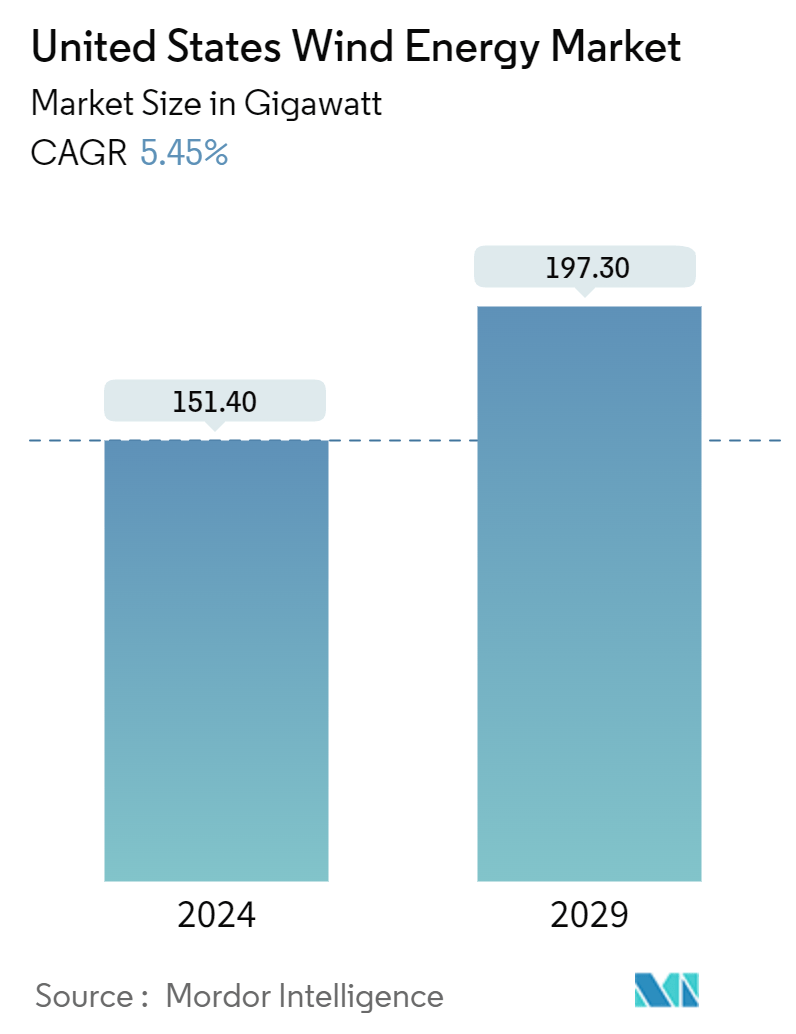
| Study Period | 2020 - 2029 |
| Base Year For Estimation | 2023 |
| Market Volume (2024) | 151.40 gigawatt |
| Market Volume (2029) | 197.30 gigawatt |
| CAGR (2024 - 2029) | 5.45 % |
| Market Concentration | Medium |
Major Players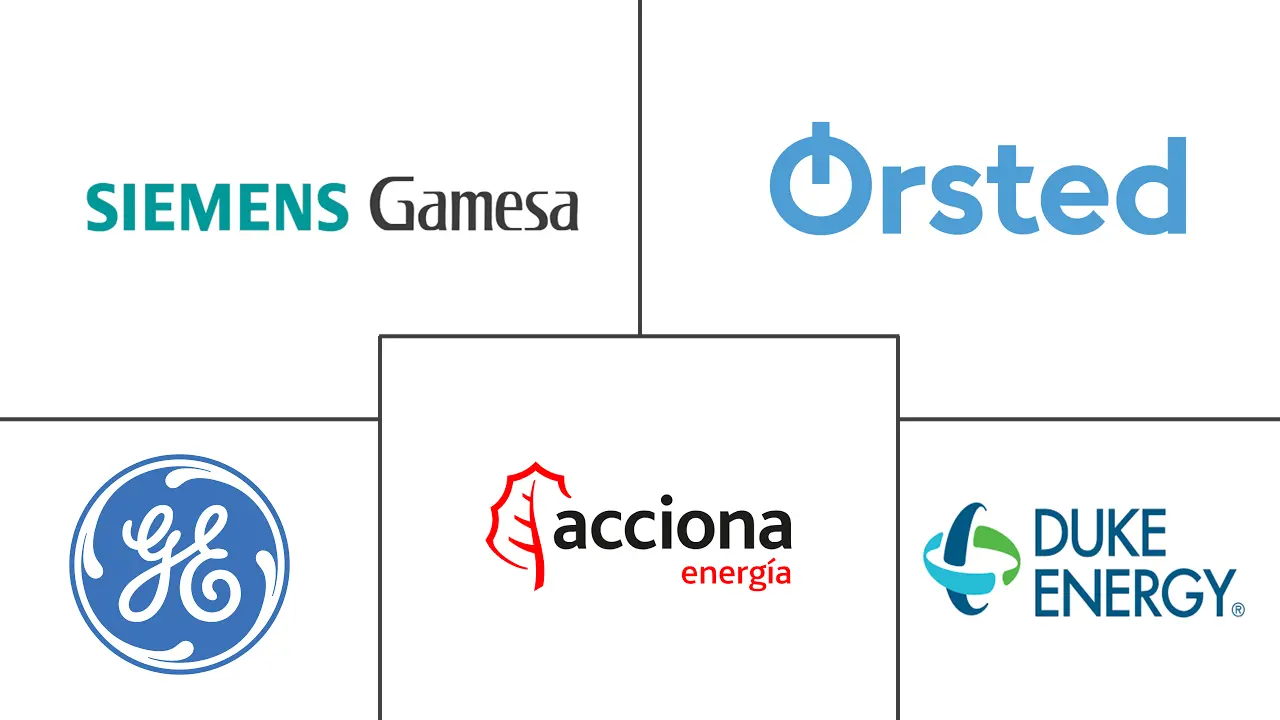
*Disclaimer: Major Players sorted in no particular order |
United States Wind Energy Market Analysis
The United States Wind Energy Market size is estimated at 151.40 gigawatt in 2024, and is expected to reach 197.30 gigawatt by 2029, at a CAGR of 5.45% during the forecast period (2024-2029).
- Over the medium term, factors such as government funding and federal incentives, including the Inflation Reduction Act (IRA), tax credits and subsidies, investments in wind energy projects, and decreasing cost of wind turbines are expected to drive the growth of the US wind energy market.
- On the other hand, competition from other renewable energy technologies is expected to hinder the market growth during the study period.
- The expansion of the wind energy industry in the offshore region is likely to create an opportunity for the market to grow in the coming years.
United States Wind Energy Market Trends
The Onshore Segment to Dominate the Market
- Onshore wind energy refers to electricity produced by wind turbines situated on land, harnessing the natural flow of air. It is one of the fastest-growing renewable energy technologies in the United States. Wind turbines do not release air or water pollutants, making them important for a future carbon-free energy industry.
- In the last five years, onshore wind energy technology has advanced to maximize electricity output per installed megawatt. Despite a drop in natural gas prices in 2023, wind energy continued to positively impact the grid, human health, and the environment by reducing emissions of nitrogen oxides and carbon dioxide.
- For instance, in 2023, onshore wind energy installations in the United States were around 150.43 GW, a 4.2% increase compared to the 144.3 GW of onshore wind energy installations in 2022. The increase in wind power is due to tax incentives from the Inflation Reduction Act, which makes wind energy more affordable. Additionally, decreasing wind energy costs and increasing investments in the supply chain boosted its growth.
- In July 2024, the 500 MW High Prairie Wind Farm in Missouri became operational, featuring 175 advanced wind turbines. This project is expected to generate enough electricity to power approximately 120,000 homes annually. It is part of Ameren Missouri’s USD 4.5 billion investment plan to add 3,100 MW of clean energy capacity by 2030. The High Prairie Wind Farm is projected to significantly contribute to Missouri’s goal of achieving net-zero carbon emissions by 2050.
- According to the Global Wind Energy Council, nearly 653 GW of onshore projects are likely to be commissioned between 2024 and 2028 in countries like China, the United States, and Europe.
- Therefore, onshore wind energy is expected to expand in the coming years with additional investments, technological advances, and economic growth.
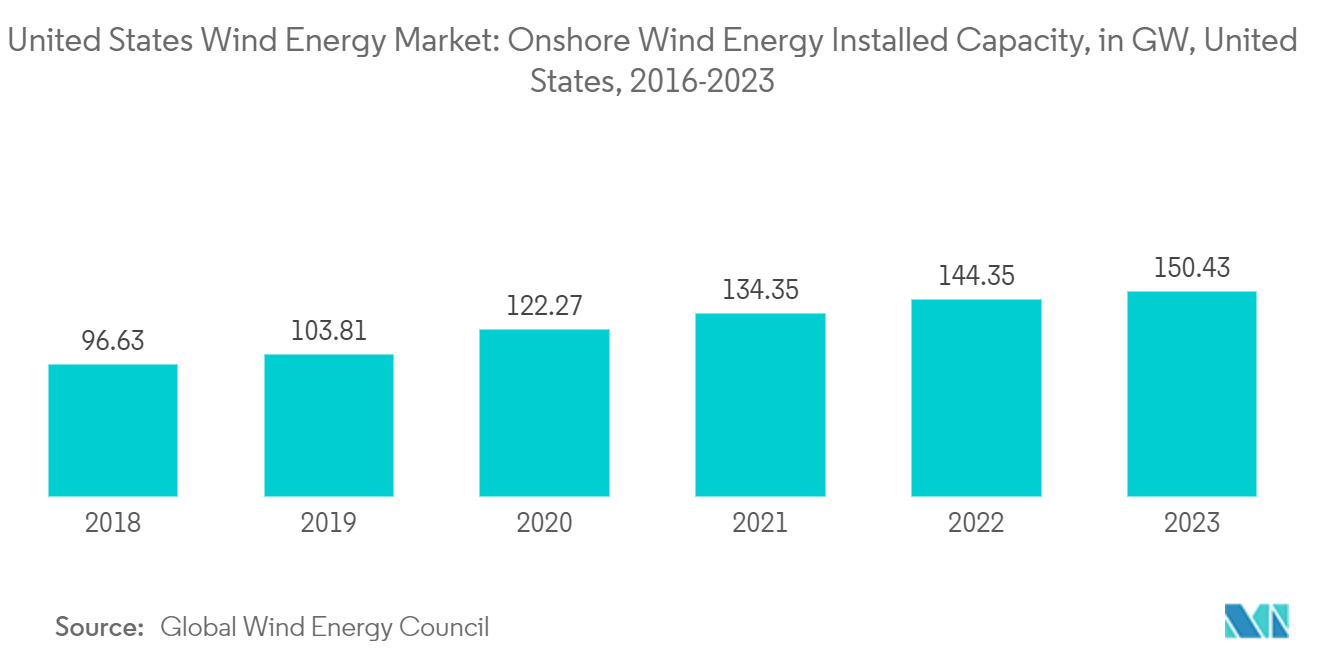
Increasing Investments to Drive the Market
- Due to the increasing demand for electricity, the United States is promoting the growth of wind energy to meet power needs. Many multinational corporations and local firms are investing in the wind energy industry with the help of the governments of federal provinces in the United States.
- In September 2023, the Biden administration announced USD 10 billion to strengthen the US offshore wind energy supply chain. This investment is expected to involve developing ports, vessels, and workforce development, which may greatly increase investor confidence. This initiative aims to expedite the shift to renewable energy and fortify the economy.
- For instance, in March 2024, the first commercial-scale offshore wind power plant in the United States, situated off the coast of Thode Island, began delivering power. The facility comprises 16 turbines, each with a capacity of 8.2 megawatts (MW), which can produce 130 MW in total. The infrastructure for offshore wind energy in the United States has advanced significantly with this milestone.
- Three major offshore wind projects are under construction in the Atlantic. Vineyard Wind 1, of Massachusetts, will have an 800 MW capacity to power 400,000 homes. Revolution Wind, between Rhode Island and Massachusetts, will have a 704 MW capacity for 250,000 homes. Ocean Wind, off New Jersey, will have a 1.1 GW capacity to power 500,000 homes. These projects are boosting the US offshore wind energy capacity.
- In 2023, wind energy generation in the United States reached 429.5 TWh, a slight decrease compared to 438.7 TWh in 2022. This represents a 2.1% decline in electricity generation from wind energy sources year-over-year. Despite this reduction, the overall trend from 2018 to 2023 reflected significant growth, with wind energy generation increasing by 56% over the five-year period.
- Hence, such developments in the wind energy industry are expected to drive the growth of the market in the upcoming years.
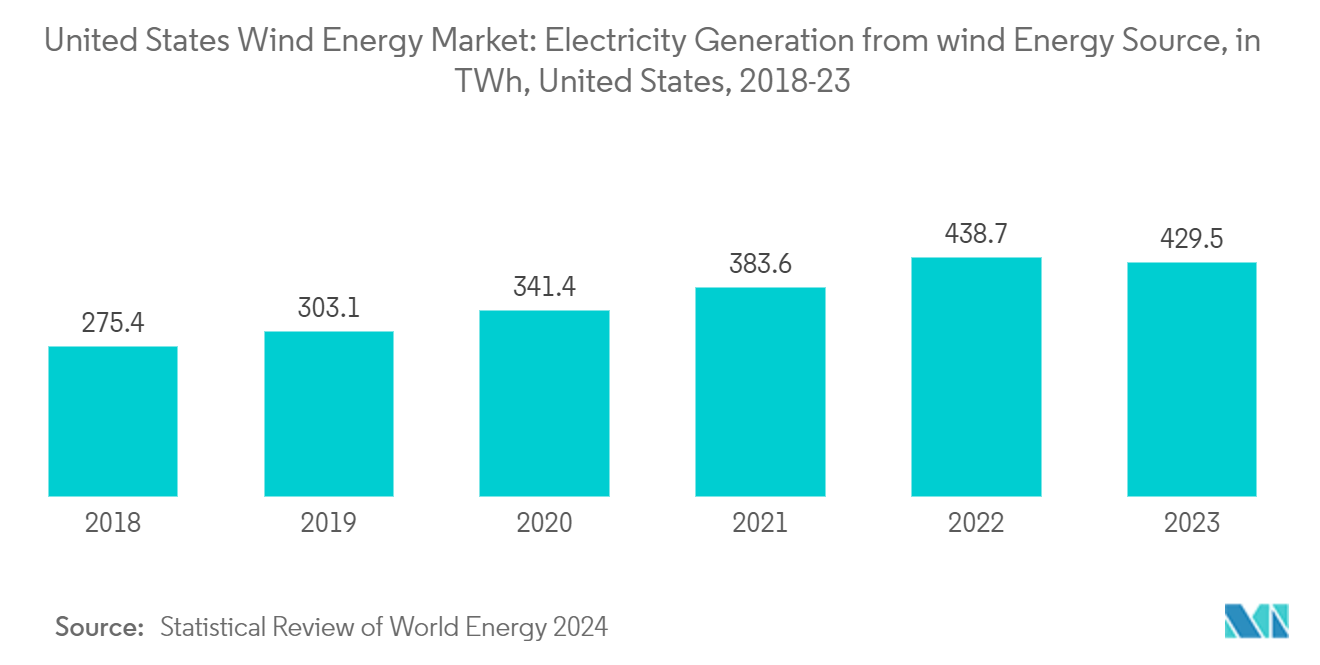
United States Wind Energy Market New
The US wind energy market is fragmented. Some key players include Acciona Energia SA, Duke Energy Corporation, Oersted A/S, General Electric Company, and Siemens Gamesa Renewable Energy.
United States Wind Energy Market Leaders
-
Acciona Energia SA
-
Orsted AS
-
General Electric Company
-
Siemens Gamesa Renewable Energy
-
Duke Energy Corporation
*Disclaimer: Major Players sorted in no particular order
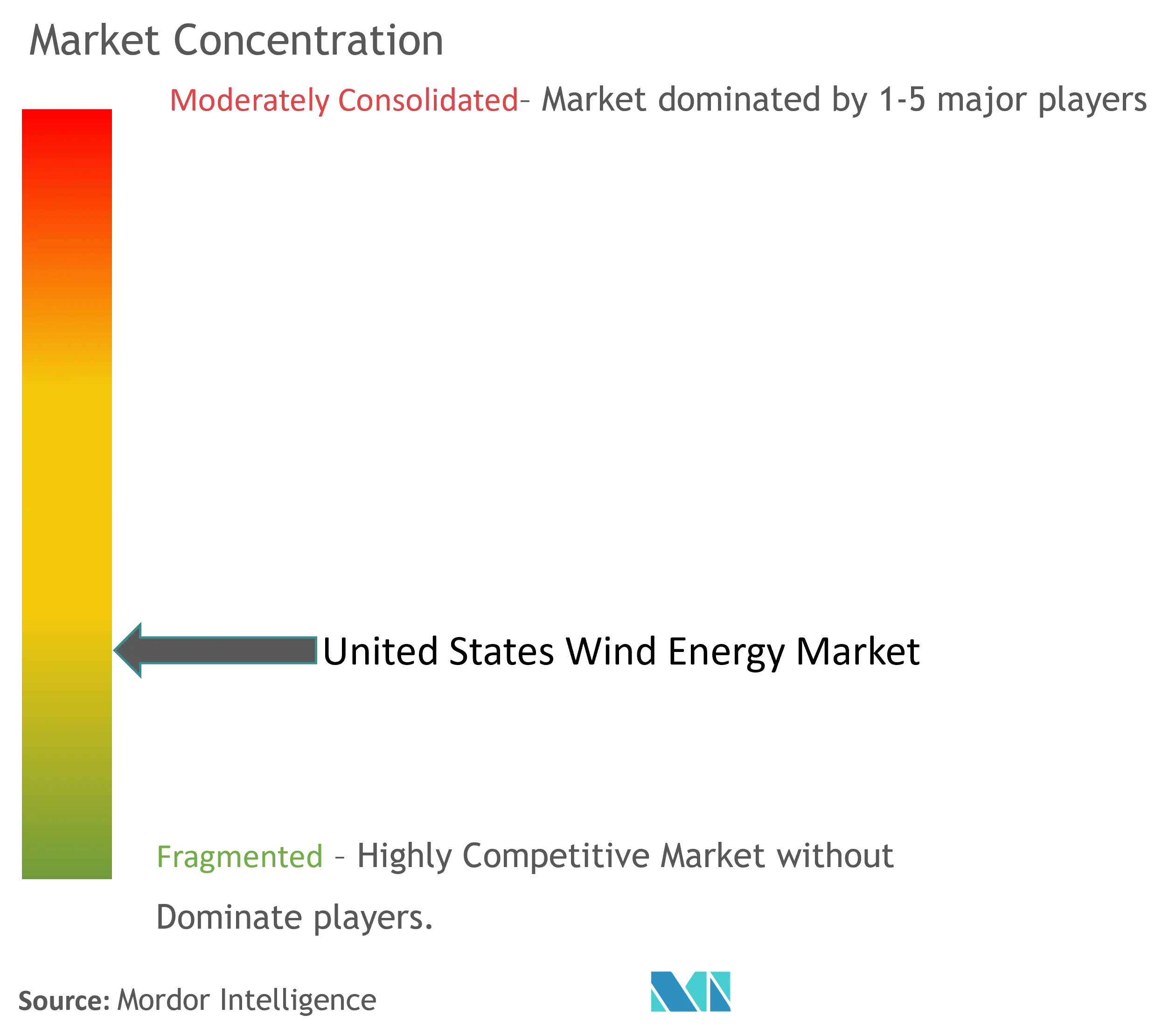
United States Wind Energy Market News
- June 2024: The Beakat Farm in Texas began operation with a capacity of 400 MW. This project is set to generate approximately 1.3 million megawatt-hours (MWh) of electricity annually, further solidifying Texas's position as a leader in wind energy with a substantial wind power capacity of over 30 GW.
- September 2024: The Biden-Harris administration approved the Maryland Offshore Wind Project. This project is part of a broader initiative to achieve 30 gigawatts of offshore wind energy by 2030. Once operational, the project is expected to produce over 2 GW of clean energy.
US Wind Energy Market Report - Table of Contents
1. INTRODUCTION
1.1 Scope of the Study
1.2 Market Definition
1.3 Study Assumptions
2. EXECUTIVE SUMMARY
3. RESEARCH METHODOLOGY
4. MARKET OVERVIEW
4.1 Introduction
4.2 Installed Capacity and Forecast in GW, until 2029
4.3 United States Renewable Energy Mix, 2023
4.4 Recent Trends and Developments
4.5 Government Policies and Regulations
4.6 Market Dynamics
4.6.1 Drivers
4.6.1.1 Supportive Regulations and Tax Incentives Boost Wind Energy Investments
4.6.1.2 Increasing Investments in Wind Projects
4.6.2 Restraints
4.6.2.1 Increasing Competition from Alternate Renewable Energy Technologies
4.7 Supply Chain Analysis
4.8 PESTLE Analysis
4.9 Investment Analysis
5. MARKET SEGMENTATION - BY LOCATION
5.1 Onshore
5.2 Offshore
6. COMPETITIVE LANDSCAPE
6.1 Mergers and Acquisitions, Joint Ventures, Collaborations, and Agreements
6.2 Strategies Adopted by Leading Players
6.3 Company Profiles
6.3.1 Wind Farm Operators
6.3.1.1 Acciona Energia SA
6.3.1.2 Orsted AS
6.3.1.3 Duke Energy Corporation
6.3.1.4 NextEra Energy Inc.
6.3.1.5 Trident Winds Inc.
6.3.1.6 E.ON SE
6.3.1.7 EDF SA
6.3.1.8 EnBW Energie Baden-Wurttemberg AG
6.3.2 Equipment Suppliers
6.3.2.1 Envision Energy
6.3.2.2 General Electric Company
6.3.2.3 Siemens Gamesa Renewable Energy
6.3.2.4 Vestas Wind Systems AS
- *List Not Exhaustive
6.4 List of Other Prominent Companies
6.5 Market Ranking Analysis
7. MARKET OPPORTUNITIES AND FUTURE TRENDS
7.1 Expansion in the Offshore Sector
United States Wind Energy Industry Segmentation
Wind energy is a renewable energy source that harnesses the energy of wind to generate electricity, which is usually generated using a wind turbine. Wind turbines are mechanical systems that convert kinetic energy into electrical energy. Wind power is sustainable and has a much smaller environmental impact compared to fossil fuels.
The US wind energy market is segmented by location into onshore and offshore. The report offers market sizes and forecasts in terms of installed capacity (GW) for all the above segments.
US Wind Energy Market Research FAQs
How big is the United States Wind Energy Market?
The United States Wind Energy Market size is expected to reach 151.40 gigawatt in 2024 and grow at a CAGR of 5.45% to reach 197.30 gigawatt by 2029.
What is the current United States Wind Energy Market size?
In 2024, the United States Wind Energy Market size is expected to reach 151.40 gigawatt.
Who are the key players in United States Wind Energy Market?
Acciona Energia SA, Orsted AS, General Electric Company, Siemens Gamesa Renewable Energy and Duke Energy Corporation are the major companies operating in the United States Wind Energy Market.
What years does this United States Wind Energy Market cover, and what was the market size in 2023?
In 2023, the United States Wind Energy Market size was estimated at 143.15 gigawatt. The report covers the United States Wind Energy Market historical market size for years: 2020, 2021, 2022 and 2023. The report also forecasts the United States Wind Energy Market size for years: 2024, 2025, 2026, 2027, 2028 and 2029.
What are the major deal types in the US Wind Power Market?
The major deal types in the US Wind Power Market include a) Asset Transactions and Debt Offerings b) Private Equity and Acquisition c) Partnerships, Equity Offerings, and Mergers
What are the major deal types in the US Wind Power Market?
The major deal types in the US Wind Power Market include a) Asset Transactions and Debt Offerings b) Private Equity and Acquisition c) Partnerships, Equity Offerings, and Mergers
US Wind Energy Industry Report
The US wind power market is experiencing significant growth, driven by a robust increase in installed capacity and a variety of deal types such as asset transactions, debt offerings, and mergers. Dominated by onshore wind capacity, the market is projected to continue its steady growth, supported by several active plants like the Traverse Wind Project and Buffalo Gap, which significantly boost power generation capabilities. This expansion is underpinned by favorable government policies and increasing investments, expected to drive further technological advancements in both onshore and offshore segments. The growth trajectory is bolstered by ongoing developments and a rising number of wind power projects aimed at meeting the growing energy demands and addressing environmental concerns. As a crucial part of the nation's energy strategy, wind energy is a key component in the United States' transition to renewable energy sources. For a detailed market forecast outlook and historical overview, access statistics and analysis from ����vlog��ý™ Industry Reports, available as a free report PDF download.



